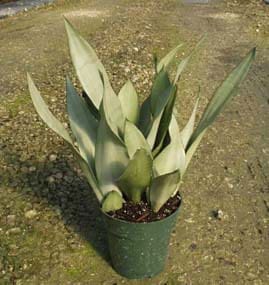How Do You Care For Snake Plants?
Sansevieria grows best in bright indirect light. Snake plants will grow outdoors in full sun or indoors in low-light areas.
Sansevierias do not need lots of water. Overwatering can cause root rot. Plant in well-drained soil. Allow soil to dry between watering.
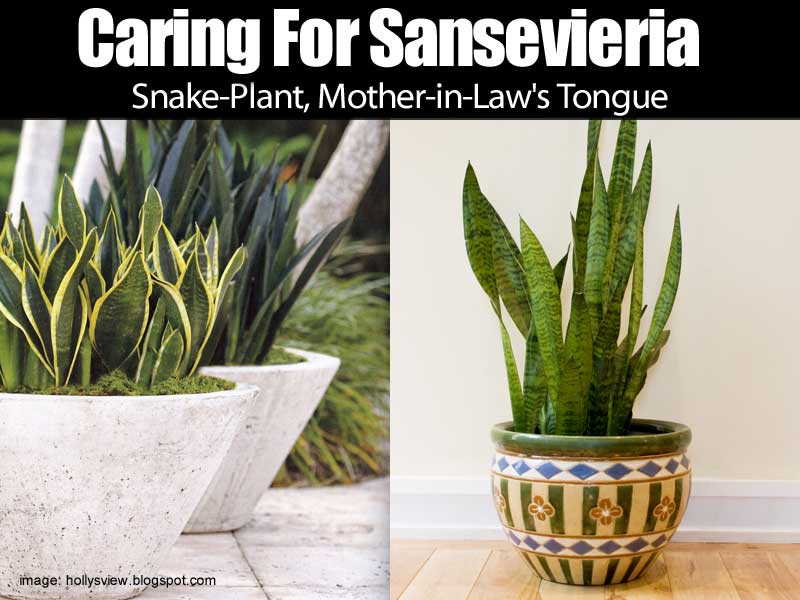
Related: More on snake plant soil.
Snake Plant Quick Care Tips
- Botanical Name: Sansevieria
- Common Name(s): Snake plant, Mother-in-law plant, Viper’s bowstring hemp, Devil’s tongue, Jinn’s tongue, Snake tongue
- Synonyms: Phal, Butterfly Orchid
- Pronunciation: San-suh-VEER-ee-uh
- Family & Origin: Asparagaceae family, native to Southeast Asia, Africa, and Madagascar
- Growability: Easy to grow
- Grow Zone: 9 – 11
- Size: Can grow up to 6″ inches to 42″ inches tall
- Flowering: Greenish-white clustered flowers on slender stalks
- Light: Grows in both bright indirect light (also full sun) and indirect, low-light areas
- Humidity: Around 40% humidity levels.
- Temperature: Warm temperatures between 70 and 90 degrees Fahrenheit.
- Soil: Well-draining soil
- Water: Water thoroughly, allowing the soil to completely dry between waterings
- Fertilizer: Lightly fertilize with liquid 20-20-20 houseplant fertilizer 1/2 strength or a slow-release fertilizer.
- Pests & Diseases: Common pests include mealybugs and spider mites; watch for root rot
- Propagation: Can be propagated through leaf cutting or division of the plant
- Plant Uses: Indoor decoration, gift plant, air purifier
- How Do You Care For Snake Plants?
- Snake Plant Quick Care Tips
- What Is A Snake Plant?
- Types Of Sansevieria
- How Often Should You Water In Sansevieria Care?
- Potting & Repotting The Mother In Law Plant
- The Snake – One Tough Indoor Plant
- One Downside To Mother-in-Law's Tongue
- Propagation – Dividing & Leaf Cutting
- Uses For The "Snake"
- Q&A: How To Care For Snake Plants
What Is A Snake Plant?
The Sansevieria pronounced (san-se-vi-ee’-ri-ah) or snake plant – is a genus of perennial herbs with stiff, very thick leaves, often mottled with white, and clustered flowers on slender stalks.

A member of the Asparagaceae Family, popularly goes by other common names. The very “politically correct” Mother-in-Law’s tongue, snake tongue, mother’s plant, and Viper’s Bowstring-hemp.
On the off-chance that some of you may have just recently returned from a prolonged stay in Tibet, and thus may not be acquainted with sansevierias, let’s start at the beginning.
The Viper’s Bowstring Hemp: A Well-Known Stranger
Sansevieria is undoubtedly one of the most easily recognized plants in the world.
Honestly, “Who, doesn’t know about snake plants?” I soon discovered, surprisingly enough, except for a few academic papers, very little has been published about this group of low light plants.
The genus was named after the Prince of San Severo, who was born in Naples in 1710.
The primary plant of the genus Sansevieria trifasciata, originates from tropical Africa, Madagascar, and Asia. The plant was originally prized for the useful fibers obtained from its leaves.
This is where the common name “bowstring hemp” came from. Where the common name mother-in-law’s tongue plant came from, I have no idea.

The plants are often called, perhaps only colloquially, “snake plants”, although most people know it by that name, this name is more properly applied to a totally different genus.
The confusion that results from one common name being applied to several, unlike plants, is one reason why many shy away from using common names.
The Sansevieria has been in cultivation for over 250 years but has grown in the US foliage trade since the 1920s.
A tender evergreen perennial with stiff, erect, thick, spearlike leaves with a glossy texture about 2′ foot long. Distinctly marked white-and-green or yellow-and-green foliage.
Sansevieria laurentii is always at the top of any list as being one of the most tolerant (like zz plant care) of all decorative plants. They survive the most unsuitable growing conditions, abuse, and neglect a plant could receive.
It’s recommended that those interested in feng shui improve the indoor air quality of structures with “sick building syndrome.”
Although this houseplant will stand more neglect than almost any other plant, overwatering a Sansevieria is harmful. The snake plant is easy to care for, and you have to work really hard to kill a sansevieria.
Related: What Are The Snake Plant’s Light Requirements?
Types Of Sansevieria
The genus boasts about 70 varieties, but roughly 15 varieties find themselves grown commercially.
Snake plants come in two types: Tall, upright growers and bird nest type

The Upright Snake Plants
The well-known tall, upright snake plant varieties include:
- Sansevieria trifasciata – grows tall, with bold stiff, glossy, leather-like gray-green leaves with dark green crossbands.
- Sansevieria trifasciata laurentii – A variegated and much showier cultivar of Sansevieria trifasciata introduced by Emile Laurent. The plant looks just like trifasciata – except for the yellow banding on the outside edges of the leaves.
- Sansevieria Black Coral – Mature upright leaves develop light gray-green cross-banding over the dark green base color.
- Sansevieria zeylanica – According to the University of Florida – “Most plants sold as Sansevieria zeylanica are trifasciata. True Sansevieria zeylanica has little appeal as an ornamental.” [source]
- Sansevieria masoniana – known as the Whale Fin snake plant. It has leaves of enormous size.
- Sansevieria Black Gold – Makes an excellent choice for a narrow space. Succulent, lance-shaped green leaves with a golden trim around the edges.
… of which you’ll find several forms.
The Bird Nest Trifasciata ‘Hahnii’
Many enjoy the tough, cast-iron qualities of sansevierias but not the stiff upright appearance. To the rescue is the ‘Bird’s Nest Sansevieria Hahnii.”
This appealing little dwarf sansevieria issued a plant patent in 1941, has sword-shaped leaves 6″ inches long, randomly mottled in green and grey. The leaves grow upward from a rhizome, or underground stem, in a funnel-shaped rosette.
These smaller “rosette” varieties carry a more graceful design. These “squashed-down” bird nest varieties hold the same “tough qualities” as the upright types.
Sansevieria golden Hahnii, has two or three broad bands of yellow and several longitudinal yellow stripes.
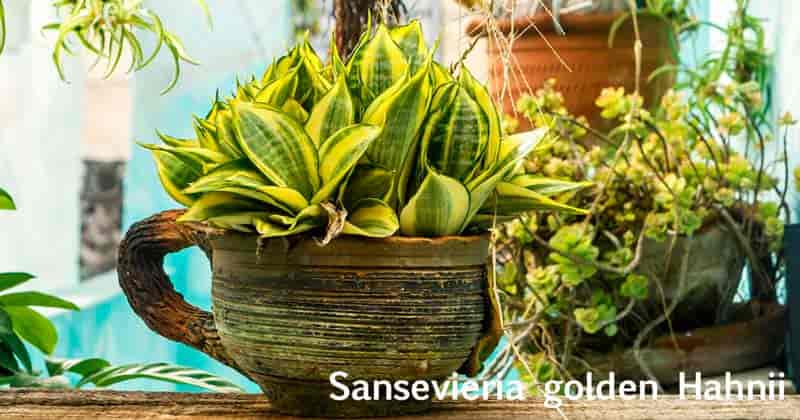
The bird nest types plants make excellent “dish-garden” and terrarium plants. it’s also compact in shape and durable.
For more check out our article on the Bird’s Nest Sansevieria Hahnii including it’s “discovery” in a New Orleans nursery. Another is the dwarf Sansevieria samurai.
How Often Should You Water In Sansevieria Care?
Be cautious when watering snake plants, especially during the winter. The wintertime is when most people experience root rot from too much water.
TIPS: Better to err on the dry side. Watering is usually a matter of personal judgment. I water my snake plants whenever they seem to need it, about every 2-3 weeks. I always allow the plant root area and soil to dry between watering, before watering again.
Few plants should be kept constantly wet, fewer should ever be allowed to suffer from lack of moisture. Reduce watering when plants are in low-light areas.
Moreover, they thrive at around 40 percent humidity levels.
Related: What Houseplants Do Well In Cold Rooms?
Potting & Repotting The Mother In Law Plant
Dividing snake plants at any time during the year; however, spring is the best.
The plants are easily increased by division; since most sansevierias sucker freely from the base of the plant, this is usually the preferred method of propagation.
They may also be increased by cutting the leaves into three-inch lengths and inserting the lower third of these in damp sand.

With this method, however, the yellow banding or marginal stripes may be lost, with the new plants reverting to type.
How to repot snake plants and what’s the best potting soil?
Remove the plant from of the pot. Using a knife or sharp clippers cut it up as much as you want. Plant each piece along with their roots in a container with a well-drained soil like this at Amazon.
Note: When repotting plants such as Sansevieria, it is not always necessary to transfer them to a larger pot unless you want to increase the size of the plant.
The growing season for Sansevieria is during the summer. Dividing in spring will produce the quickest results. Each division will soon grow and produce an attractive plant.
Snake plants do well in good potting soil as they are not very demanding. Sansevierias are very “succulent“; “heavy plants” which hold lots of water in their leaves. It is often recommended to create a “heavy soil” by amending the potting mix with some sand.
The Snake – One Tough Indoor Plant

Plants, as with fashion, seem to come and go and come back again. Over the last few years, Sansevieria started to make somewhat of a comeback.
No discussion on hardy houseplants would be complete without some comments on the Sansevieria or Viper’s bowstring hemp.
This well-known genus has many friends and some enemies.
The critics call attention to the snake plant’s stiff, upright growth habit, and they are apt to name it mother-in-law’s tongue or snake plant. Devoted friends, on the other hand, praise its hardy constitution and ability to thrive under exceedingly difficult conditions.
Others approve of the modernistic form of the plant and select it for backgrounds calling for vertical lines.
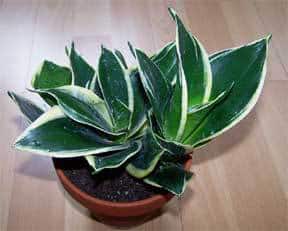
The viper’s bowstring hemp makes a great houseplant due to their versatility in both size, use and growing conditions.
You’ll find Sansevieria used in small dish gardens all the way up into 14″ containers 42″ inches in height. They handle full sun, look great on a patio during the spring and summer, but also can go inside into very low light.
In fact, the toughness of low-light snake plants makes them one of the Best Bathroom Plants for low or no-light areas.
This plant can hang with the best of all low light plants. However, the plant will do best in bright light.
The Mother’s Tongue plant, the spider plant, and others were the Top plants NASA tested and found for absorbing carbon dioxide and releasing oxygen at night.
Sansevieria does this through the crassulacean acid metabolism process.
This plant grows best in warm temperatures between 70 and 90 degrees Fahrenheit.
Cold temperatures below 45° degrees Fahrenheit for extended periods are one climatic condition it will not tolerate. When the plants become damaged, they can show up slowly over a 1- 4 week period.
One Downside To Mother-in-Law’s Tongue
Everything seems to have a downside, and the Sansevieria is no different. Their downside – weight.
Because of their relationship to the succulent family, they hold a lot of water.
As plants reach 10″ and larger in pot size the weight goes up dramatically. I’ve seen 10″ plants that weight 25 pounds or more.
If You Want A Houseplant That:
- Is tough indoors
- Can be placed just about anywhere
- Takes up little space
- Goes a long time to watering
- A good starter plant for the house
- Can start outside in spring and move inside More on growing Mother in Law outdoors
- Has no real pests problems. Spider mites even have a difficult time with their succulent plant leaves.
Take a look at the Sansevieria.
Propagation – Dividing & Leaf Cutting
In south Florida, stock plants grow in beds out in full sun. One very unusual production method of this crop; growers actually mow down the tops of the plants forcing them to produce new growth.
Details on Snake Plant Propagation
Sansevierias propagate easily by division; since most varieties sucker freely produce rhizomes, this is usually the preferred method of propagation. Snake plants propagate from leaf cuttings, clumps, or rhizome cuttings.
Propagate by cutting the leaves by cutting leaves into three-inch lengths, and inserting the lower third of these in damp sand. With this method, however, the yellow banding or marginal stripes may be lost, with the new plants reverting to type.

This video from Nell provides lots of details on repotting snake plants.
Sansevieria Cylindrica – The Popular Oddball
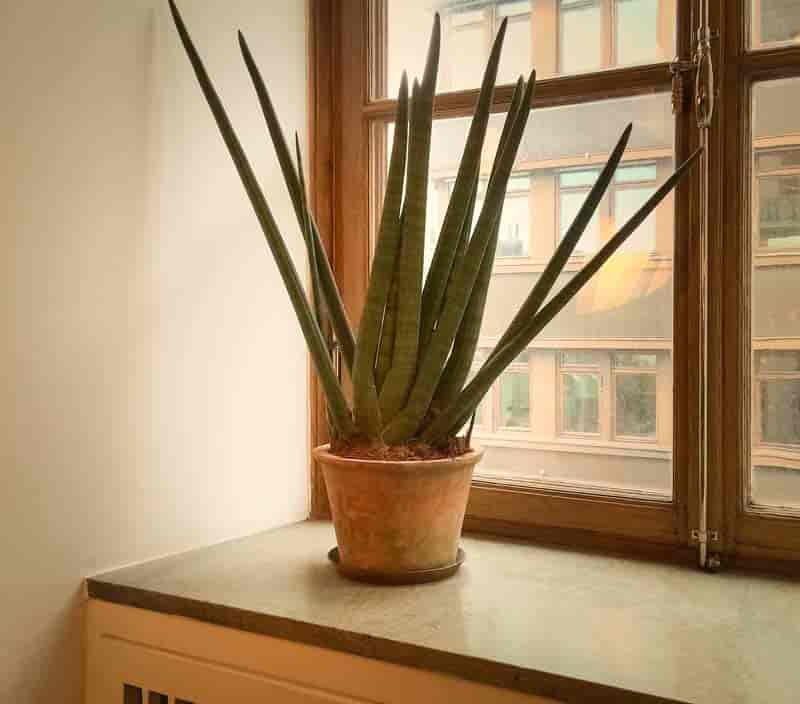
One odd sort you may discover when searching for a “different” or rare sansevieria species is Sansevieria “cigar” cylindrica. The plant has dark green leaves marked with faint light green bands. It reminds me of the “garden asparagus.”

A native to Angola, sometimes called the African spear, Cylindrical Snake Plant, Spear Sansevieria, used as an ornamental plant because of its unique features.
The difference? The leaves are cylindrical instead of flat or concave. This somewhat fan shape plant is also found in Sansevieria Ehrenbergi, a much more colorful plant with red and white pencil stripes on the upper margins of its bluish leaves.
Another unusual type I’ve become mildly fond of is Sansevieria arborescens, a sort of tree-like plant wholly unlike the customary stemless varieties. This, by the way, has white edges on dull green leaves.
It is a fan shape plant but some gardeners and growers have experimented with braiding.

Sansevieria cylindrica is a low-maintenance houseplant, versatile and drought-tolerant. In fact, it seems to thrive best with little water. Also check out the compact Starfish Snake Plant.
Almost like the ZZ plant or cast-iron plant and other of the best indoor houseplants they do fine when watered once or twice a month or less when if used indoors as a houseplant.
Uses For The “Snake”
The durability of Sansevieria makes it an excellent choice for apartment dwellers who often have limited success with houseplants due to low-light issues. They should take a good look at the bowstring hemp plant.
Sansevierias adapt to almost any temperature fluctuations and light conditions. True, the plants will freeze if it gets too cold and sunburn if it is too hot, and no plant will grow in absolute darkness.
They will tolerate very dim low light for long periods and can be used in many places where other houseplants would scarcely survive a week.

Display Them Attractively
Too many people lose half the beauty of their houseplants (not only sansevierias, but others, too) by not displaying them properly.
Some varieties of sansevieria, notably those whose silhouettes are unusual, deserve to be grown as individual specimens; others look better when used in group plantings.

An attractive pottery container greatly enhances the appearance of these plants.
Admittedly Sansevierias plants are not the most very graceful plant. The compact bird’s nest species Sansevieria Hahni are more interesting in their smaller size and also tolerant of dry hot rooms and poor light.
The bird nest varieties are perhaps of the greatest value to the window gardener, with their amiable disposition, which allows them to persist under the most adverse conditions.
Keep leaves clean and free from dust and grease. Other care consists of keeping the soil mix moist but not wet and feeding occasionally.
Sansevieria Hahni with short leaves arranged in a rosette. Hahni makes and excellent low plant for use on a coffee table where little light may be available.
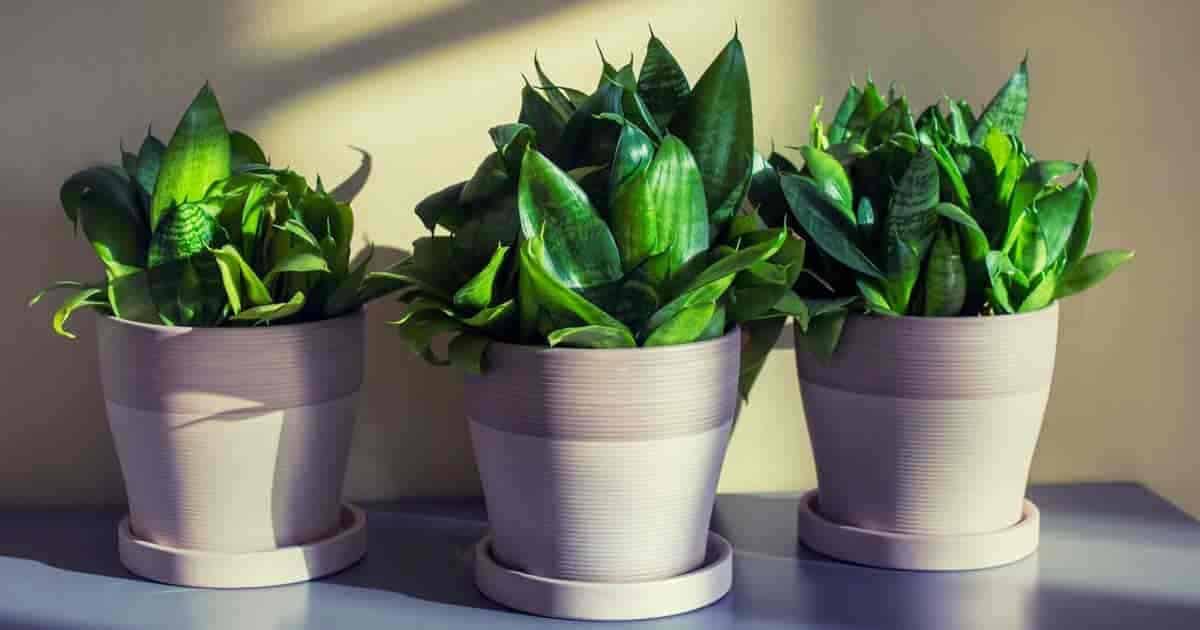
Q&A: How To Care For Snake Plants
Does Sansevieria Bloom or Flower?
Primarily used as foliage plants but when conditions suit them Sansevierias will burst suddenly and unexpectedly into glorious bloom. The psychological reaction for most sansevieria owners is comparable to finding a peacock on their front lawn!
A friend describes the plants as “inelegant” either never saw one in bloom or else needs new glasses.
Granted, individually snake plant flowers do not look like much, but borne in racemes on tall, foot long, stout scapes, making a lovely display. The blossoms usually white or cream, sometimes greenish (those of Sansevieria cylindrica have a pinkish color), are often fragrant.
By now you probably know how tough and durable qualities of the “Mother-in-law plant.” If you’re looking for other tough and easy care houseplants to keep indoors also consider the:
- ZZ plant (zamioculcas)
- Cast-Iron plant
- Aglaonema
When Is The Best Time To Repot or Transplant?
I have a pot of sansevieria that has so many young ones coming up the plants are very crowded. When is the best time to transplant some of these into another container? Kaleigh, Memphis, Tenn.
Divide Sansevierias at any time during the year, and each division will soon grow into a nice plant. Remove the plant out of the pot, break it up as much as you want and plant each part. The plants grow actively during the summer, so spring is the best time to divide a snake plant to obtain quick results.
Is The Mother In Law’s Tongue Plant Poisonous?
The Mother In Law’s Tongue plant is low in toxicity to people but according to the ASPCA – all parts of the snake plant are poisonous or toxic to cats and dogs.
For more check out these articles on its poisonous or toxic properties.
- Is Snake Plant Toxic to Humans?
- How Toxic are Snake Plants to Cats?
- Are Dogs Safe Around Snake Plants?
Why Do Snake Plants Leaves Fall Over?
Leaves falling or flopping over are usually caused by several conditions:
- Overwatering
- Low light issues
- Incorrect repotting practices – make sure drainage hole is open
Read our article for details on the Causes and Prevention of Snake Plant leaves falling over
Can You Root Mother In Law’s Tongue Plants In Water?
Can you tell me how to start another viper’s bowstring hemp sansevieria plant? I’ve tried rooting leaves in water, but this method doesn’t seem to work. Nina, Michigan State University
Nina, the common variety of Sansevieria roots readily from cuttings.
- Cut a leaf into four-inch sections
- Plant each in sandy soil, one inch deep.
How Often to Water a Snake Plant Cutting?
- Firm the soil so that the leaf will not fall over when watered.
- Water sparingly and keep the cuttings in a warm bright place.
- Each piece of the leaf will produce a new plant.
The Sansevieria with the yellow margin on the leaf propagates only by division, each piece with roots will soon produce a new one.
If the leaves with yellow margins are used as a leaf cutting, the plant, if it does grow, will revert back to the green leaf and lose its yellow margins.
Generally, Sansevieria cuttings in the water get too much moisture and decay.
More on propagating Sansevieria
Where Can You Buy Types of Mother In Law’s Tongue Plant?
The “Mothers Plant” is available at most home improvement stores and garden centers.
The small birdnest types of viper’s bowstring hemp are often found in dish gardens, the larger varieties are usually available in 4″ inch and 6″ inch sizes.
Below is a list of 50 species and Sansevieria varieties recognized by The World Checklist of Selected Plant Families at Kew as of August 23, 2017.
- S. aethiopica (1794)
- S. arborescens (1903)
- S. ascendens (2010)
- S. bacularis (2010)
- S. bagamoyensis (1913)
- S. ballyi (2004)
- S. bella (2000)
- S. burdettii (2000)
- S. burmanica (1915)
- S. conspicua (1913)
- S. downsii (2000)
- S. dumetescens (2009)
- S. ebracteata (1988)
- S. ehrenbergii (1875)
- S. fasciata (1903)
- S. fischeri (1986)
- S. forskaliana (1983)
- S. frequens (2000)
- S. gracilis var. gracilis
- S. gracilis var. humbertiana (2007)
- S. gracillima (2005)
- S. hargeisana (1994)
- S. hyacinthoides (1913)
- S. kirkii var. kirkii
- S. kirkii var. pulchra (1915)
- S. lineata (2013)
- S. longiflora var. fernandopoensis (1915)
- S. longiflora var. longiflora
- S. longistyla (2004)
- S. lunatifolia (2015)
- S. metallica var. nyasica (1915)
- S. newtoniana (2014)
- S. nilotica (1875)
- S. parva (1915)
- S. patens (1915)
- S. pearsonii (1911)
- S. pedicellata (2004)
- S. perrotii (1901)
- S. phillipsiae (1913)
- S. pinguicula (1964)
- S. pinguicula subsp. disticha (2012)
- S. pinguicula subsp. pinguicula
- S. powysii (2010)
- S. senegambica (1875)
- S. sordida (1915)
- S. subspicata (1889)
- S. suffruticosa (1915)
- S. suffruticosa var. longituba (1981)
- S. suffruticosa var. suffruticosa
- S. volkensii (1895)
Image: Top source

